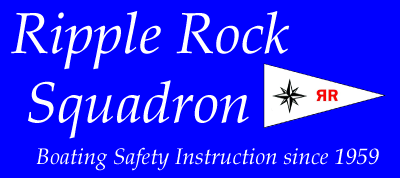Navigation Lights - The Basics. No complications, such as towing.
Caution:
- The following information has been simplified so we can give you a basic introduction using (mostly) non-technical language. Review the actual Regulations for in-depth information (we have noted the rule number, in square brackets, where practical). The Regulations can be found on our links page.
- A lot of effort has been made to ensure the information is correct, but errors may occur (If you find one please leave a message for our Webmaster).
- This information is intended for boaters on the BC Coast; it does not address modifications for vessels operating in the Great Lakes Basin.
Vessel under oars (rowboat, canoe, kayak) or under Sail, under 7 metres in length
[Rule 25 d]

- Preferred option is sidelights and stern light (no white masthead light for a vessel under sail or oars) as it is easier for other vessels to determine "aspect" (which way your vessel is pointing), but this is an option if not practical.
- The light shall consist of an electric torch or lighted lantern showing a white light, which shall be shown in sufficient time to prevent collision.
Aide-Memoire: "(Red) Port is not right for young children"
Power Driven Vessel less than 12m in length
[Rule 23 d]

- A typical small Power driven Vessel, the rules allow the Masthead light and Stern light to be combined as shown. The all round light may be aft as shown, or forward.
- On a vessel of less than 12 metres, the sidelights may also be in a combined lantern, so would be very close together.
- If the vessel is using a single, all round light, and is trimmed by the stern (not fully on step or uneven loading) an aft mounted combined masthead/stern light may not be very visible from ahead.
Power Driven Vessel under 50 metres
[Rule 23]

- A typical medium size cabin cruiser is shown, but any power driven vessel up to 50 metres will show the same lights.
- The masthead light must now be separate from the stern light.
Power Driven Vessel over 50 metres
[Rule 23]

- A typical aft houseworks freighters lights are shown. If the vessel has its houseworks midships (think Powell River Queen) the sidelights may be midships. If the housework is forward (or extends bow to stern - think cruise ship), the sidelights will likely also be forward.
- The main change is the addition of the second white masthead which not only gives an indication of the length of the vessel, but also forms a "range" to give a better estimate of the vessel's "aspect"
- A smaller vessel may also show a second masthead light, but is not required to do so.
Vessel under sail less than 20 metres in length
[Rule 25 b]

- Preferred option is separate nav lights (as shown below), as a combined lantern at masthead is often difficult to spot from other vessels, particularly if they are watching the horizon.
- If the sailing vessel is less than 7 metres, it may use the first option on this list.
- Note that if the vessel is also under power, it is no longer considered to be a vessel under sail, At night it must show nav lights for a power driven vessel, and during the day, if more than 12m in length and not within a harbour etc. must show a conical shape apex downwards [Rule 25 e and f].
Vessel under Sail
[Rule 25 a and c]

- The red and green, all round lights, at the masthead are optional.
- As above note that if the vessel is also under power, it is no longer considered to be a vessel under sail, At night it must show nav lights for a power driven vessel, and during the day, must show a conical shape apex downwards [Rule 25 e]
Vessel at anchor
[Rule 30]

- This diagram shows a vessel of less than 50m at anchor. If the vessel is over 50m it would show a second white light aft, lower than the forward light. If the vessel is over 100m it is also required to use available working lights to illuminate her decks. (Smaller vessels may also use working lights to illuminate their decks.)
- Fishing vessels, Pilot vessels and some other vessels may also show their special lights when anchored.
